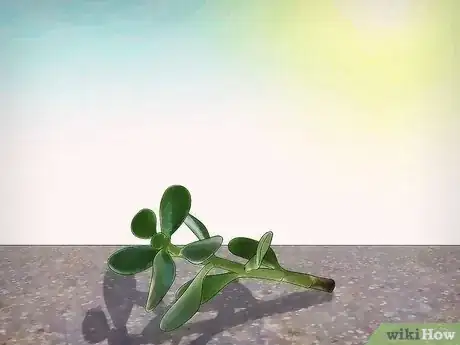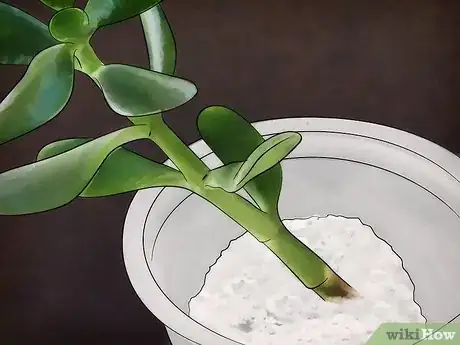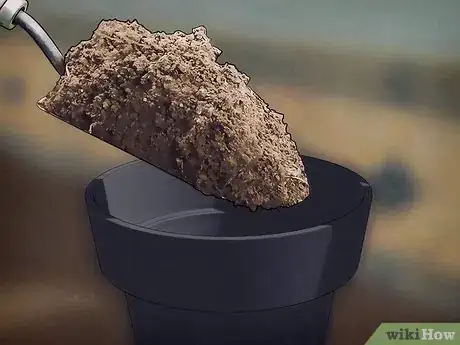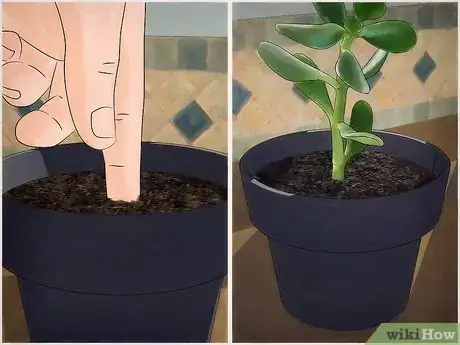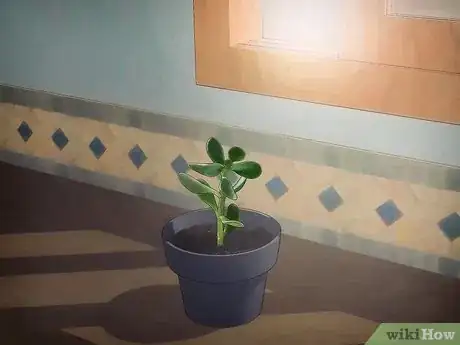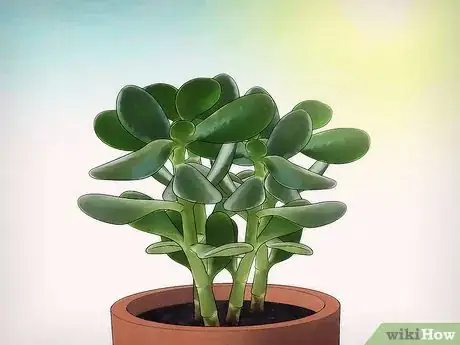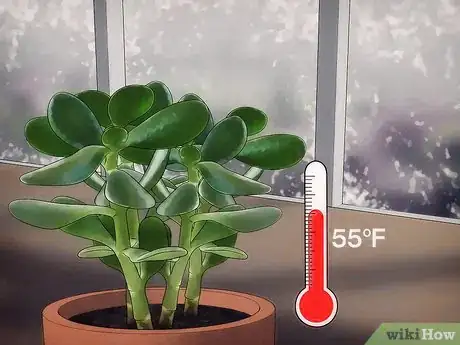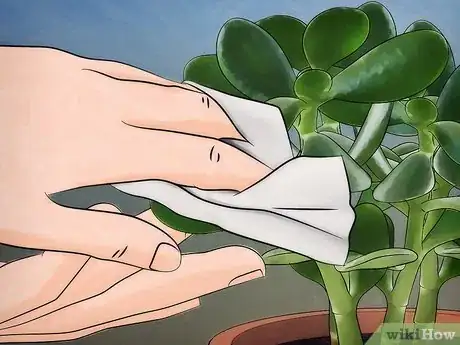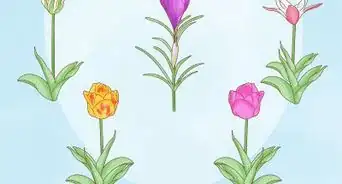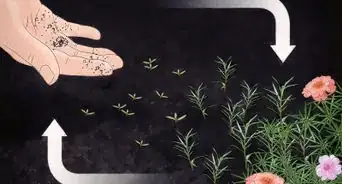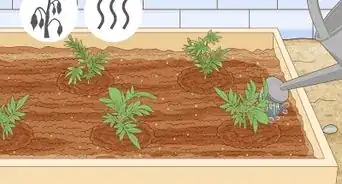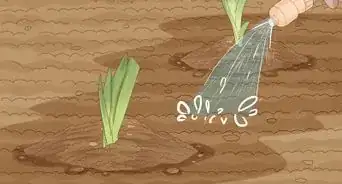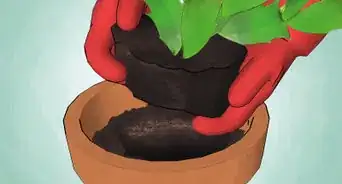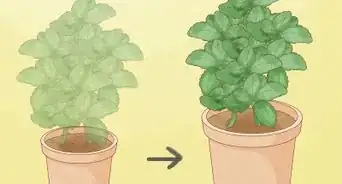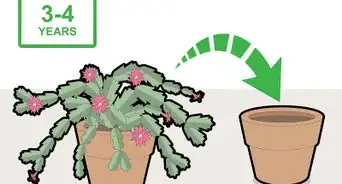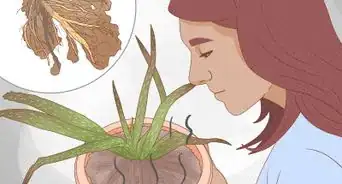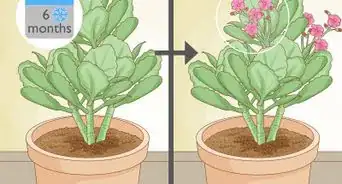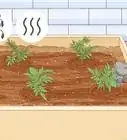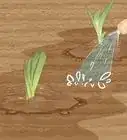This article was co-authored by Melinda Meservy. Melinda Meservy is a Plant Specialist and the Owner of Thyme and Place, a botanical boutique offering plants and gifts in Salt Lake City, Utah. Before starting her own business, Melinda worked in process and business improvement and data analytics. Melinda earned a BA in History from the University of Utah, is trained in lean and agile methodologies, and completed her Certified Professional Facilitator certification. Thyme and Place offers indoor plants and containers, a fully stocked potting bench, and tips on plants to suit your space and lifestyle.
There are 14 references cited in this article, which can be found at the bottom of the page.
wikiHow marks an article as reader-approved once it receives enough positive feedback. This article received 19 testimonials and 89% of readers who voted found it helpful, earning it our reader-approved status.
This article has been viewed 562,165 times.
Jade plants (sometimes called a money plant) are a type of succulent plant. These plants are easy to grow and maintain; thus, they are a common choice for many plant lovers. They don’t require a lot of water, and can live for many years. Additionally, they can also easily be grown from small clippings. If you would like to grow your own Jade plant, take steps to learn how to grow, care for, and maintain a Jade plant.
Steps
Growing a Jade Plant from a Cutting
-
1Choose a cutting. If you have a large Jade plant (or know someone who does), you can grow more Jade plants by cutting off a stem from the larger plant. Try to choose a part of the plant that has a thick stem with healthy leaves.[1]
- Use sharp, clean clippers to snip off the stem. Make sure to leave a few inches of space between the bottom of the stem and the leaves so that you won’t have to remove any leaves when you plant it.
-
2Allow the stem to dry out a bit. Giving the cutting a few days to dry out and scab over will help keep your little Jade plant healthy while it is rooting. All you have to do is leave the cutting in a dry place until it seems a bit dry. The place where you cut the stem should be scabbed over.[2]
- The larger the cutting, the more time this will take. It will also take longer if you are doing this in the winter as opposed to during the warm summer months.
Advertisement -
3Apply a rooting hormone. Rooting hormone (also called rooting tonic) is a mix of different plant hormones that will help cuttings grow more successfully.[3] You can make your own homemade rooting hormone or you can purchase a commercial rooting hormone.
- If you purchase a commercial rooting hormone, you should follow the instructions provided. However, in general, you will apply the rooting hormone directly to the stem that will be placed in the soil. Do this just before planting.[4]
- To avoid contaminating your bottle of rooting hormone, pour a small amount into a container. Use the hormone in your vessel for the propagation work and discard any leftover. This way, the rest stays fresh.
- This step is optional. Though it may increase your chances of success, Jade plants are known for their ability to root successfully on their own.
-
4Fill a container with the correct soil. You should not use regular potting soil for your Jade plant as it is too heavy for this plant to root in. Instead, purchase a soil made specifically for succulent plants or mix your own and add a few handfuls of sand for better drainage. The key to remember is that Jade plants need soil that drains well.[5]
- You can mix your own soil by mixing together a combination of sand, perlite, and a compost of some sort. Succulents prefer soil that drains easily, so it is important to avoid regular potting soil. You can find all of these ingredients at a nursery.[6]
- If you are worried about your plant draining well enough, use a clay pot instead a plastic pot. Make sure that there is a drainage hole on the bottom where water can escape. If there is a saucer underneath the pot, always empty out any excess water.
- Jade plants don’t need a huge amount of space, so if you have a small clipping you can use a pot that is small.
-
5Plant the Jade. Use your finger or a pencil to make a small hole in the soil (just big enough for the stem to fit into). Place the stem into the hole so that the rooting hormone is covered (if you used it). If you didn’t use root hormone, just place the stem in deep enough so that the plant can stand up on its own.[7]
- Pack the soil in loosely around the stem. You don’t have to pack it in too tightly as this will discourage drainage. Just pack it tight enough so that the stem feels secure in the pot.
- If planting the cutting directly doesn’t work for you, try rooting it in water. Place your cutting in a jar with the tip of the stem just above the surface of the water. The cutting will begin to root, and then you can plant it.[8]
-
6Place the plant in a sunny spot.[9] It is important that the small plant is kept in a sunny place, but do not place it in direct sunlight as the leaves will burn. In three to four weeks, you should notice new growth on the top of the plant. This is a good sign that your plant has successfully rooted.[10]
- Avoid the temptation to water your plant while it is rooting. This will increase the chance that the stem will rot and kill your rooting plant altogether.
- Once your Jade plant has rooted, you can consider moving it to a larger pot if you want to.
- If your plant doesn’t seem to be rooting, and it’s only been a few weeks, try waiting a bit longer. Succulent plants root easily, so it may just be that you haven’t given the plant enough time. Alternatively, you can gently remove the cutting from the pot to see if roots are growing. Don’t do this too often, though, as it only slows the process.[11]
Caring for a Jade Plant
-
1Allow the plant to dry out before watering. Jade plants are succulents, which means that, while they do need water, they don’t need a lot. If you touch the soil and it feels moist, the plant does not need water. On the other hand, if you notice the leaves are starting to wilt then you know the plant is not getting enough water.[12]
- Stick your finger up to the first knuckle into the soil. If it is dry, then it is OK to water it. If it is still moist, then it doesn’t need more water.[13]
- In the winter months, your plant will likely need even less watering than normal so be sure to always check the soil.[14]
- Many people recommend watering succulents by soaking the entire pot in a tub of water, which allows the plant to soak up the water from the bottom. However, you can also water the plant by pouring water into the pot through the top. The most important thing is that you allow the excess water to drain completely from the pot.
- Do not leave the Jade plant sitting in water. If you notice excess water, be sure to empty it from the saucer.
- Try to avoid getting the leaves wet when watering.
-
2Place the plant in a sunny area.[15] Jade does need a lot of sunlight, but that doesn’t mean it needs to be in full sun for the entire day. Avoid placing your jade plant in a south-facing window, as it will probably burn. Instead, look for a place where your plant will get about 3 to 5 hours of sun each day.[16]
- Move your plant in stages. For example, if you have been keeping your jade in a dark, shadowy corner, but want to move it to a bright window sill, don’t just pick the plant up and plop it on the window sill. Such an extreme change is likely to cause the leaves of the Jade to burn and fall off. Instead, move the plant gradually so it has time to adjust. For example, move the plant out of the dark corner to a place where it may get an hour of indirect sunshine. Leave it there for at least a few days before moving it to an area with a bit more sunshine. Keep doing this until you’ve got your plant to the desired location.
-
3Keep the plant neat. If any leaves have fallen off the tree into the pot, remove them. You can also prune your plant to keep it healthy. If you want to prune your jade, you can remove just about anything you want, but avoid messing with the main stem too much, or you may kill the plant.[17]
- Cutting off new growth will help the plant stay more bush-like and less spindly.
-
4Keep the plant at the right temperature. Jade plants are very hardy and easy to keep alive, so you don’t have to worry much about whether the temperature is right. Keep them in a place at room temperature. This means that you shouldn’t place them in a south facing window where they will receive direct sunlight for most of the day.[18]
- In the winter, they prefer a slightly cooler temperature (e.g. around 55 degrees Fahrenheit or 13 degrees Celsius).
Maintaining a Jade Plant
-
1Change the soil every two to four years. Though you can leave the plant in the same pot for many years, as long as you are not overwatering it, changing out the soil every two to four years will give you a chance to inspect the roots for any damage or rot. Additionally, giving the plant some fresh dry soil will make sure the plant continues to flourish.[19]
- If you notice that a Jade plant you’ve had for many years is not doing well anymore, replanting it may help it spring back.
-
2Wipe down leaves to remove dust. If your plant is dusty, you can use a soft cloth to gently remove dust. Alternatively, if it is a rainy day, it is OK to place the plant outside, which will help rinse off the dust.[20]
- Make sure, though, that if the leaves get wet, they are able to dry out completely. A plant with water left on the leaves may rot or grow mildew.
-
3Take care of any bug infestations. It is not a common problem, but Jade plants can become infested with bugs. If you notice a problem with small mealybugs on your plant, use a bit of rubbing alcohol and a cotton swab to gently wipe down the leaves of your plant.[21]
- When looking for bugs, look for small, fluffy, white deposits on the leaves. These are a sign that there are bugs. Additionally, you can use a magnifying glass to identify red spiders, which are too small to see with the naked eye.[22]
- Avoid using an insecticidal soap on your plant as this may damage the leaves.
- Bugs can be a sign that your plant is unwell. Getting your plant healthy again will usually prevent pests.[23]
Expert Q&A
Did you know you can get premium answers for this article?
Unlock premium answers by supporting wikiHow
-
QuestionDo jade plants need a lot of sunlight?
 Melinda MeservyMelinda Meservy is a Plant Specialist and the Owner of Thyme and Place, a botanical boutique offering plants and gifts in Salt Lake City, Utah. Before starting her own business, Melinda worked in process and business improvement and data analytics. Melinda earned a BA in History from the University of Utah, is trained in lean and agile methodologies, and completed her Certified Professional Facilitator certification. Thyme and Place offers indoor plants and containers, a fully stocked potting bench, and tips on plants to suit your space and lifestyle.
Melinda MeservyMelinda Meservy is a Plant Specialist and the Owner of Thyme and Place, a botanical boutique offering plants and gifts in Salt Lake City, Utah. Before starting her own business, Melinda worked in process and business improvement and data analytics. Melinda earned a BA in History from the University of Utah, is trained in lean and agile methodologies, and completed her Certified Professional Facilitator certification. Thyme and Place offers indoor plants and containers, a fully stocked potting bench, and tips on plants to suit your space and lifestyle.
Plant Specialist
-
QuestionDoes my plant need to be root-bound to be put into a larger container?
 Katie GohmannKatherine Gohmann is a Professional Gardener in Texas. She has been a home gardener and professional gardener since 2008.
Katie GohmannKatherine Gohmann is a Professional Gardener in Texas. She has been a home gardener and professional gardener since 2008.
Professional Gardener
-
QuestionI put my jade plant in my office where there is no direct sunlight. It's since dropped all its leaves. How can I save the plant?
 Katie GohmannKatherine Gohmann is a Professional Gardener in Texas. She has been a home gardener and professional gardener since 2008.
Katie GohmannKatherine Gohmann is a Professional Gardener in Texas. She has been a home gardener and professional gardener since 2008.
Professional Gardener
Warnings
- This type of plant is poisonous to both cats and dogs. If you have cats or dogs, be sure the Jade plant is kept out of their reach, or consider getting a type of plant that is not toxic for them.[24]⧼thumbs_response⧽
References
- ↑ http://getbusygardening.com/propagating-jade-plants/
- ↑ http://getbusygardening.com/propagating-jade-plants/
- ↑ http://www.gardenfundamentals.com/rooting-hormones-what-are-they/
- ↑ http://getbusygardening.com/propagating-jade-plants/
- ↑ http://getbusygardening.com/propagating-jade-plants/
- ↑ http://extension.psu.edu/plants/gardening/fact-sheets/general-gardening/homemade-potting-media
- ↑ http://getbusygardening.com/propagating-jade-plants/
- ↑ http://www.shopterrain.com/article/propagating-succulents
- ↑ Melinda Meservy. Plant Specialist. Expert Interview. 18 August 2020.
- ↑ http://getbusygardening.com/propagating-jade-plants/
- ↑ http://garden.sffood.net/how-to-propagate-succulents/
- ↑ http://www.clemson.edu/extension/hgic/plants/indoor/foliage/hgic1507.html
- ↑ http://getbusygardening.com/tips-for-jade-plant-care/
- ↑ http://www.healthyhouseplants.com/index.php/plant-of-the-month/jade.html
- ↑ Melinda Meservy. Plant Specialist. Expert Interview. 18 August 2020.
- ↑ http://succulent-plant.com/families/crassulaceae/moneyplant.html
- ↑ http://getbusygardening.com/tips-for-jade-plant-care/
- ↑ http://www.almanac.com/plant/jade
- ↑ https://davesgarden.com/guides/articles/view/2224/
- ↑ http://oldfashionedliving.com/jadeplant.html
- ↑ http://www.clemson.edu/extension/hgic/plants/indoor/foliage/hgic1507.html
- ↑ http://succulent-plant.com/families/crassulaceae/moneyplant.html
- ↑ Melinda Meservy. Plant Specialist. Expert Interview. 18 August 2020.
- ↑ http://www.aspca.org/pet-care/animal-poison-control/toxic-and-non-toxic-plants/jade-plant
About This Article
To grow a jade plant, start by clipping a stem from an existing plant and leaving it to dry for a few days, or until the cut part is scabbed over. Next, dip the cut end into rooting hormone to encourage the cutting to grow roots. Then, plant the jade in a pot filled with succulent potting mix and loosely pack the soil around the stem. Finally, place the plant in a sunny spot and water it only when the soil has completely dried out to avoid overwatering. For tips from our Horticulture reviewer on maintaining a jade plant after it’s established, read on!

